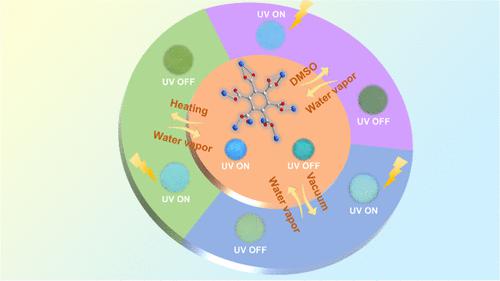当前位置:
X-MOL 学术
›
Chem. Mater.
›
论文详情
Our official English website, www.x-mol.net, welcomes your feedback! (Note: you will need to create a separate account there.)
Dehydration-Triggered Afterglow Transition in a Mellitate-Based Coordination Polymer
Chemistry of Materials ( IF 8.6 ) Pub Date : 2023-03-27 , DOI: 10.1021/acs.chemmater.3c00321 Shuang Wang 1 , Yin-Jing Shi 1 , Song Chen 1 , Zhiqing Lin 1 , Zhixin Jiang 1 , Wei-Ming Liao 1 , Jun He 1
Chemistry of Materials ( IF 8.6 ) Pub Date : 2023-03-27 , DOI: 10.1021/acs.chemmater.3c00321 Shuang Wang 1 , Yin-Jing Shi 1 , Song Chen 1 , Zhiqing Lin 1 , Zhixin Jiang 1 , Wei-Ming Liao 1 , Jun He 1
Affiliation

|
Stimulus-responsive long persistent luminescence (LPL) materials have attracted wide attention due to their potential applications in information storage, anti-counterfeiting, optoelectronic devices, etc. However, LPL coordination polymers with room temperature afterglow transition characteristics have not been explored. Herein, mellitic acid and zinc ions were utilized to synthesize an acid–base stable coordination polymer (1) by an organic solvent-free hydrothermal method. 1 possesses a tightly stacked structure and exhibits dual-emission peaks with blue luminescence and blue-green afterglow. Upon exposure to heating, DMSO immersion, or vacuum, 1h, 1s, and 1v were obtained. The original blue luminescence changes to blue-green, while the afterglow turns yellow-green due to the loss of water molecules from the inner cavity. This is the first example of an LPL coordination polymer that can realize room temperature afterglow transition by dehydration operation. Moreover, the emission spectra of 1 can be recovered by exposing 1h, 1s, or 1v to water vapor, suggesting a reversible dehydration/hydration process. Experimental and density functional theory (DFT) results suggest that the fluorescence of 1 originates from the mixing of intra-ligand and ligand-to-metal charge transfer excited states. The triplet state from intersystem crossing is responsible for the long persistent luminescence of phosphorescence emission. The rational structural design along with the conceptual model of anti-counterfeiting and information encryption based on afterglow transition display the unique advantages of the LPL coordination polymer in realizing convenient multiple stimuli-responsive devices.
中文翻译:

苯六酸酯基配位聚合物中脱水触发的余辉跃迁
刺激响应长余辉发光(LPL)材料因其在信息存储、防伪、光电器件等方面的潜在应用而受到广泛关注。然而,具有室温余辉跃迁特性的LPL配位聚合物尚未得到探索。在此,利用苯六甲酸和锌离子通过无有机溶剂水热法合成酸碱稳定的配位聚合物(1 )。1具有紧密堆叠的结构,具有蓝色发光和蓝绿色余辉的双发射峰。暴露于加热、DMSO 浸泡或真空时,1h、1s和1v获得。原来的蓝色发光变成蓝绿色,而余辉则由于内腔失去水分子而变成黄绿色。这是首个通过脱水操作实现室温余辉转变的LPL配位聚合物实例。此外,可以通过将1h、1s或1v暴露于水蒸气来恢复1的发射光谱,表明这是一个可逆的脱水/水合过程。实验和密度泛函理论 (DFT) 结果表明1的荧光起源于配体内和配体到金属电荷转移激发态的混合。来自系统间交叉的三重态负责磷光发射的长期持续发光。合理的结构设计以及基于余辉跃迁的防伪和信息加密概念模型显示了LPL配位聚合物在实现便捷的多重刺激响应器件方面的独特优势。
更新日期:2023-03-27
中文翻译:

苯六酸酯基配位聚合物中脱水触发的余辉跃迁
刺激响应长余辉发光(LPL)材料因其在信息存储、防伪、光电器件等方面的潜在应用而受到广泛关注。然而,具有室温余辉跃迁特性的LPL配位聚合物尚未得到探索。在此,利用苯六甲酸和锌离子通过无有机溶剂水热法合成酸碱稳定的配位聚合物(1 )。1具有紧密堆叠的结构,具有蓝色发光和蓝绿色余辉的双发射峰。暴露于加热、DMSO 浸泡或真空时,1h、1s和1v获得。原来的蓝色发光变成蓝绿色,而余辉则由于内腔失去水分子而变成黄绿色。这是首个通过脱水操作实现室温余辉转变的LPL配位聚合物实例。此外,可以通过将1h、1s或1v暴露于水蒸气来恢复1的发射光谱,表明这是一个可逆的脱水/水合过程。实验和密度泛函理论 (DFT) 结果表明1的荧光起源于配体内和配体到金属电荷转移激发态的混合。来自系统间交叉的三重态负责磷光发射的长期持续发光。合理的结构设计以及基于余辉跃迁的防伪和信息加密概念模型显示了LPL配位聚合物在实现便捷的多重刺激响应器件方面的独特优势。


























 京公网安备 11010802027423号
京公网安备 11010802027423号